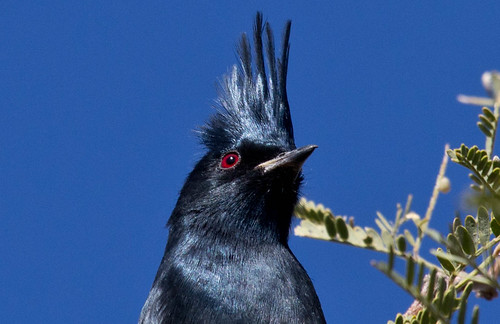Phainopepla
| Phainopepla nitens | Order: Passeriformes | Family: Ptiliogonatidae (Silky-flycatchers) |
This lovely representative of the “silky flycatcher” family is found in Mexico and in the desert Southwest of the United States, with a few records of vagrants as far north as Canada and as far east as Nantucket Island. Adult males are striking, glossy black. Young birds and adult females are soft gray. They feed heavily on mistletoe berries and other small fruits, and catch flying insects, often sallying out from exposed branches. Phainopeplas often make a soft wurp call when alighting after the short flight.
Phainopeplas are uniquely adapted to feeding on desert mistletoe. As with most berries, the seed and pulp hold almost all the nutrition, but the much less digestible skin makes those nutrients hard to access for animals that swallow the berries whole. To get enough food value from a mistletoe diet, Phainopeplas must eat as many as 1100 berries in a single day and extract the nutrition as quickly as possible. So they devour berries in rapid succession, stuffing a pouch in the esophagus called the crop. When the crop is filled to capacity, the bird retreats to a perch to quietly digest the feast.
The Phainopepla’s muscular stomach chamber, or gizzard, is very tiny, processing just one berry at a time by contracting to squeeze the seed and semi-liquid pulp directly into the small intestine as the berry’s sturdy outer skin remains in the gizzard. One by one, the berries run through the gizzard like this, the digestible pulp and seeds entering and running through the intestine as the skins accumulate in the gizzard in a compact mass. When that mass builds to hold 10 or 20 packed skins or so, the gizzard ejects it into the small intestine in a bolus separate from the pulp and seeds.
As far as I can find, the Phainopepla is the only known bird able to shuck the outer coatings of berries like this. Between swallowing the berry and it coming out the other end takes only about 12 minutes, making the system as fast as it is efficient.
Phainopeplas are unique in another way. They winter in southern Mexico, arriving in the United States between February and April. The birds in Arizona and California, the most well-studied, breed in two distinct habitats at two different times of the year. Between February and April, they breed in the Sonoran Desert in Arizona and Colorado Desert in California. As summer heat intensifies and berry supplies dwindle in May, they appear in oak and sycamore canyons where they breed through July.
Nesting Phainopeplas behave quite differently in the two habitats, too. In the desert, mated pairs are extremely territorial, probably because desert mistletoe parasitizes the same trees over and over, producing a stable, long-lasting supply of berries close to where the birds nest. But in the oak and sycamore woodlands where Phainopeplas nest in summer, they are much less territorial, nesting in loose colonies of from 3-15 pairs with overlapping home ranges, feeding on such fruits as redberry and elderberry, which grow in open areas away from the shaded nest sites in oaks and sycamores, and the fruit on feeding trees and shrubs doesn’t last long. In this habitat, foraging Phainopeplas lose less from sharing the fruits than they benefit from more eyes to search out new fruiting plants, and from working together to mob nest predators.
So far, researchers haven’t figure out whether the desert-nesting Phainopeplas in Arizona and California are the same individuals that then nest in woodlands that same year, or if these are two different breeding populations. Either way is unique.
One might think a cool word like phainopepla has an interesting origin or meaning, but it’s simply the scientific genus name given to the bird by Spencer Baird. In Greek, phainos means “shining” and peplos means “robe.” The specific epithet, nitens means “shining” in Latin, to emphasize that lovely quality. The name was given in reference to the adult male’s sleek, shining, yet non-iridescent plumage.
Laura's Published Works
Radio Programs
- The Value of eBird, Part 4: Science, Conservation, and Education 2023
- Phainopepla: A Bird as Unique as Its Name. 2022
- Phainopepla: Which way did she go? 2022
- When Rarity Begets Rarity 2022
- Laura’s Best Bird EVER! Chapter 4. Baby Joey and the Las Vegas Great-tailed Grackles 2018
- Thanksgiving Gratitude 2011
- California Birding 1994
- Why do birds have crests? And Baker's Blue Jay Hot Cereal 1990
- Waxwings 1987
